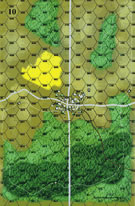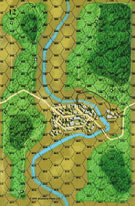|
Attack Without Pause Edelweiss: Expanded #31 |
||
|---|---|---|
| (Attacker) United States | vs | Germany (Defender) |
| Formations Involved | ||
|---|---|---|
| Germany |  |
2nd Gebirgs Division |
| United States |  |
109th "Thirteenth Pennsylvania" Infantry Regiment |

|
| Overall Rating, 2 votes |
|---|
|
2.5
|
| Scenario Rank: --- of 957 |
| Parent Game | Edelweiss: Expanded |
|---|---|
| Historicity | Historical |
| Date | 1945-02-02 |
| Start Time | 10:00 |
| Turn Count | 24 |
| Visibility | Day |
| Counters | 50 |
| Net Morale | 0 |
| Net Initiative | 2 |
| Maps | 2: 10, 12 |
| Layout Dimensions | 56 x 43 cm 22 x 17 in |
| Play Bounty | 141 |
| AAR Bounty | 166 |
| Total Plays | 2 |
| Total AARs | 1 |
| Duplicates | Edel024, EdIV039 |
| Battle Types |
|---|
| Bridge Control |
| Inflict Enemy Casualties |
| Urban Assault |
| Scenario Requirements & Playability | |
|---|---|
| Battle of the Bulge | Maps + Counters |
| Edelweiss: Expanded | Base Game |
| Introduction |
|---|
|
Transferred from northern Norway be train, ship and highway, the 2nd Mountain Division arrived on the Western Front in January, 1945. taking positions in front of Colmar, they faced the tough American XX Corps and the French Foreign Legion. The division set out a thin screen to slow the American advance, but the tactics of Finland failed in Alsace. The U.S. 28th Division, following instructions to "attack without pause," shredded the German line so quickly the mountain division reported itself under attack by an armored corps. |
| Conclusion |
|---|
|
After more than four years in the Arctic, the Edelweiss Division was a shadow of its former self. the outpost line resisted but could not stop the Americans, by now expert in tank-infantry interactions. The "Bloody Bucket" Division brushed aside the jägers and drove into Colmar, a fortress-city that had defied the French 1st Army since October. |
| AFV Rules Pertaining to this Scenario's Order of Battle |
|---|
|
| 1 Errata Item | |
|---|---|

|
The movement allowance on the counters in Airborne is misprinted. It should be "3." (rerathbun
on 2012 Jan 30)
|
| "Like crap through a..." Well, you get the idea | ||||||||||||
|---|---|---|---|---|---|---|---|---|---|---|---|---|
The recently arrived mountain troops have the honor of holding Colmar. They are facing a strong, mixed arms American force loaded down with leaders. The history shows that the jaegers were shuffled off with little difficulty and Colmar taken quickly and darn if it didn't happen again. The Germans set up with most of their force in the town and a strong roadblock in the light woods. This roadblock was endowed with the best single leader (LT 2-10-1) and great hopes were placed in its ability. The Germans also had two strong AT guns posted to see the Shermans as they poked their nose into view. The plans were well done and the short(ish) nature of the scenario (24 turns) gave them hope that they could hold onto enough of Colmar to win. The ultimate loss of Colmar was, in any event, a foregone conclusion. The Americans sent one company with two platoons of Shermans to the south, using the track, in order to split the defenders attention, while the remainder of the battalion attacked the roadblock. The flaw in the Germans plans became quickly apparent. The American OBA hammered the roadblock and caused immediate losses prior to the assault. The roadblock completely fell within the first hour. During that time, other American troops from the main assault along the road had moved forward to bring the edge of Colmar into spotting distance and Colmar started getting hit with the OBA. By turn 8 both AT guns were history without ever getting a chance to fire at tanks. The Americans wisely kept the Shermans out of sight until these guns were silenced (a +3 roll on the AT table). What followed was a sad process of mopping up the Germans in the city. The troops coming up from the south were effective but were hurt by a strong German counterattack which caused the loss of seven Shermans (3 steps, 2 to Panzerfausts). With plenty of Colmar pacified the Americans could quickly recover morale and with plenty of numerical superiority they could reinforce assaults leading to the eviction of the last three steps of German troops from Colmar by turn 18, both demoralized and with only the ranking leader left. At that point the jaegers said "Kamerad". They did cause seven step losses in infantry and the three armor step losses mentioned above so they were not toothless but the result was never really in doubt and the loss of the AT guns sealed the deal within the first two hours. Not a very exciting scenario in general although the portrayal seems typical of a 1945 West Front battle. Overmatched Germans facing insane firepower and material superiority causing losses for Western forces sufficient to cause some regret. The annihilation of the German force was never in question, the losses to the Americans were, and on that factor the Germans performed reasonably well, especially with their counterattack (3 steps of infantry and 3 of armor). This showed the tactical prowess of the Germans and how futile it all was in the end. As the Germans I never felt like I had a chance. As the Americans I wanted to avoid casualties. Perhaps this was a direct result of the scenario design. On the other hand, I played primarily during a full moon with a looming lunar eclipse. For those of you with superstitious backgrounds the moon might have had a bigger role. Me, I think the scenario is well designed. I rate the scenario a 2 merely due to its predictability. The results and the "feel" are spot on. |
||||||||||||
| 0 Comments |

 EdlX030
EdlX030 



















